
|
Back to |
| The Front Page |
| The Game |
|
An Egyptian-style mallet for Golf Croquet is now made in America |
||||||||
|
By Michael Rumbin Layout by Reuben Edwards Posted February 22, 2014
|
||||||||
|
||||||||
When Egypt nationalized the French and English holdings in the country in the 50's, the multi-sports compounds were included, and most of them had croquet along with cricket pitches and polo fields. Soon, the Egyptian Croquet Federation was playing Golf Croquet in Cairo and Alexandria, and of necessity producing their own equipment, due to a shortage of foreign exchange. So the Egyptianmade mallets and balls did not have to conform to the standards of the croquet world, which did not "discover" Egypt's comparatively large national association until the eighties. By that time, the ideal requirements of a mallet used ONLY for Golf Croquet were known, and that knowledge was incorporated into the mallets the Egyptians used to win Golf Croquet tournaments. Golf Croquet has now succeeded worldwide beyond all the expectations of the 80's and 90s. Many players in America, Europe, and the Southern Hemisphere play no other form of the game. So when the editor heard that mallets are being made in the United States exclusively for Golf Croquet, he commissioned this article from the maker.
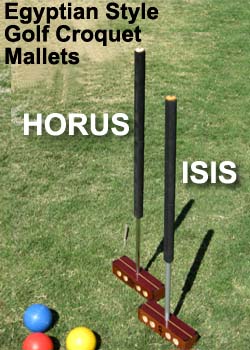
|
| Horus has a 34 inch shaft with total weight 2 lbs., 6 oz. Isis has a 32 inch shaft and weighs 2 lbs. 2 oz. Photo: M. Rumbin |
The Golf Croquet mallets I make are lighter than most, extremely durable and strong, with an "Egyptian-style" shape based on measurements taken from a private collection of mallets made in Egypt. My WoodRanch Custom Shop mallets are ideal for Golf croquet, comfortable to use for both the novice and the expert, yet versatile enough to be used as a "standard mallet" for playing other versions of croquet. It is not a "specialized" mallet by any means. It just has design and performance requirements rooted in the game of Golf Croquet. Many will find more enjoyable a mallet somewhat lighter, easier to grip, and freer in the swing than a three-pound mallet with a 36-inch shaft.
HOW IT ALL STARTED--IN PASADENA
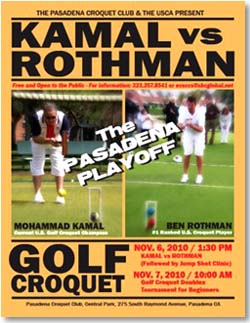
|
What's special about the Egyptian-style Golf Croquet?
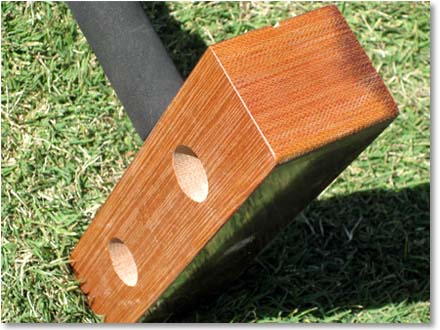
|
| Phenolic CE grade block has a fine cloth layer "grain". |
Osman Elhadary, Ahmed's father, brought several mallets from Egypt that I was able to measure for size, weight and design. All except one were made of phenolic resin C grade material. The weight of this material is comparable to high-density wood such as lignum vitae. Phenolic laminates are made by impregnating one or more layers of a base material such as canvas with phenolic resin and laminating the resin-saturated base material under heat and pressure. The resin fully polymerizes during this process.
The shafts of Osman's mallets ranged from 30 1/4 to 32 inches. Head widths were 2 1/2 inches, with a height of 2 1/8 to 2 1/4 and length of 8 1/2 to 9 inches. All the shafts were made of bamboo. The preferred mallets in this small sample weighed 2 lbs. 8 ounces or less.
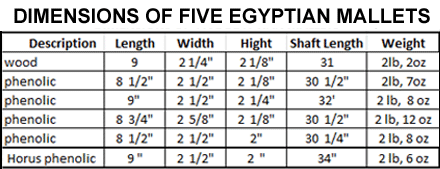
|
The measurements I made became the basis of the design of the Horus and Isis mallets. The key elements are the use of the phenolic resin material for the heads, the size/weight of the heads, and the shorter shafts of 30-32 inches. The material is indestructible, proof being the condition of your old mallets. I essentially substituted a light- weight aluminum shaft for the bamboo. This change alone dropped 4 ounces from the old weight. Today I am using only carbon fiber, because it is even lighter and stronger.
The significance of the swing and shaft dimensions
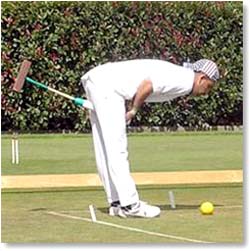
|
| Max Murray photographs a World Golf Croquet Champion, Mohamed Nasr, from the side, clearly depicting the hard-hitting Egyptian style in this shot from the 2006 World Championship in New Zealand. |
The position of the wrists in the Irish Grip forces a "straight arm" with little or no bend at the elbow. To get a full backswing it is therefore necessary to use a shorter shaft, around 30 inches, and to bend more in the waist. Many Egyptian players display a dynamic bend at the waist during the backswing. Their Big Swing is all backward swing used with a lighter mallet to build momentum.
Shafts are 30 to 34 inches at most, depending on the height of the player. Players will typically slide their grip down the shaft at about the bottom third of the height and crowd the ball for a wicket shot. With follow through, this grip position can give the ball topspin to grind through a wicket. Therefore, fabric or leather grips should run at least half the length of the shaft or more. I recommend two12-inch grips on a 34-inch shaft.
Addressing the ball: The Aim
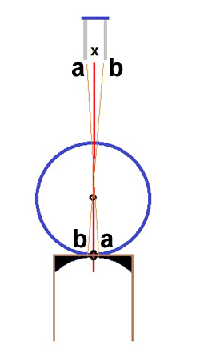 TANGENT AIM POINT |
| The flat black Ball Alignment Arc has a radius of 1 9/16 of an inch equal to the croquet ball. |
Seeing the spot where the flat of the mallet face touches the curved surface of the ball is tricky. But imagine putting two balls together, and the tangent spot is much more evident. The Horus mallet has a flat black arc corresponding to the curve of the 3 5/8 inch ball scribed into the top surface to make this alignment more evident and unmistakable from the player's point of view.
The importance of mallet weight in Golf Croquet
The old school classifies mallets by total weight, with three pounds as the standard mallet weight for Association play, that weight being comprised of the head and the shaft. Most traditional shafts are made of hickory or similar strong woods, typically weighing 12 to 14 ounces, depending on style and grip materials. This leaves about 2 pounds, 2- 4 ounces for the head. It's the momentum--mass times velocity (weight of the head times the speed of the swing)--that gets transferred into the ball to make it move. If you have to move two balls at once across the court--two pounds of weight instead of one--you will need twice as much momentum energy as required to move one ball (as in Golf Croquet.)

|
| ISIS mallet with Aim line and Ball Alignment Arc This 9 X 2 1/2 inch head weighs 1 Lb. 14 |
With 9-hoop Garden Croquet and 6-hoop American Rules and Association Croquet, these twoball croquet shots are integral to the game. A heavy mallet head is much preferred, especially when performing a full or pass roll shot. But in Golf Croquet you almost never move two balls at once, so much less momentum or weight is needed in Golf Croquet for most shots. One shot in particular--the stun shot--is best performed with no follow through, and it's easiest to get that result with a lighter mallet. Simple math would suggest a 1-pound, 1 ounce mallet head would work just fine for Golf Croquet.
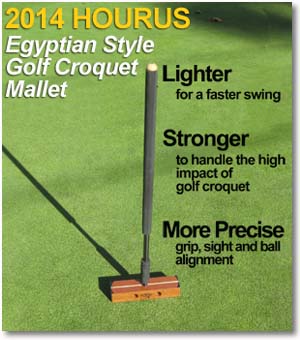
|
| Click here for more information (pdf). |
Egyptian-style design is rooted in the way Golf Croquet has been played by the Egyptians since the 1950's. While this is the branding I use, I am open to the wants of my customers. Most club players have just one mallet initially, which has to perform for them in all versions of the game. So it is no surprise that the standard 2014 Horus now comes with a Pass Roll Grip at the bottom of the shaft. Shaft lengths are available in any length. I have made mallets with heads up to 10 inches in length, but resist strongly making any head weight above 34 ounces.
For more information about HORUS and ISIS Egyptian Style Golf croquet mallets, contact Michael Rumbin at smrumbin@aol.com.
Michael Rumbin is the 9-Wicket Group Chairman of the USCA. He has been playing croquet since a young boy. He took up the game seriously in 2010 and has since competed in several local and national tournaments. His small business, WoodRanch Croquet Custom Shop, manufactures and distributes mallets, trophies, and most recently the Swing COACH and Swing COACH II for swing practice and improvement. He currently resides in Simi Valley, California with his wife Elizabeth, and is active with a local croquet club and the Pasadena Croquet Club.